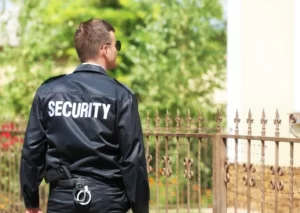In today’s unpredictable world, private protection services have become essential for ensuring safety in various situations. Whether it’s personal security or safeguarding assets, having a solid protection strategy in place is crucial.
This article will delve into the importance of private protection services and highlight ten key strategies that can enhance safety and security.
Why Private Protection Services Are Essential
Private protection services play a vital role in safeguarding individuals, organizations, and properties. They offer a professional and comprehensive approach to security that goes beyond traditional measures. These services provide peace of mind by offering personal protection, asset protection, and risk assessment. Whether it’s protecting high-profile individuals, corporate executives, or sensitive information, private protection services are tailored to specific needs and offer a layer of protection like no other.
Understanding the Importance of Safety Strategies
Safety strategies are essential for mitigating risks and ensuring the well-being of individuals and assets. They involve a systematic approach to identifying potential threats, assessing vulnerabilities, and implementing effective measures to address them. Safety strategies consider various factors, such as physical security, emergency response planning, cybersecurity, and employee training. By implementing comprehensive safety strategies, both individuals and businesses can proactively protect themselves from potential harm and minimize the impact of unforeseen events.
Secure Residential Protection
Implementing Strong Perimeter Security
To ensure the safety and security of residential areas, it is crucial to implement strong perimeter security measures. This includes installing sturdy fences, gates, and barriers that effectively restrict unauthorized access. Additionally, advanced technologies like CCTV cameras and motion sensors can be utilized to detect any suspicious activities around the perimeter. By having a well-defined and secured boundary, residents can have peace of mind and deter potential intruders.
Utilizing Surveillance Systems
Surveillance systems are essential tools in private protection services. By installing state-of-the-art cameras and monitoring systems, residential areas can be closely monitored at all times. These systems offer real-time surveillance, ensuring prompt response to any security breaches. Moreover, with the advancements in technology, surveillance systems can now be integrated with smart devices, allowing residents to have remote access and control over their security. This enables homeowners to actively monitor their property and take immediate action if any suspicious activity is detected.
These two key strategies form the foundation of secure residential protection. By implementing strong perimeter security and utilizing surveillance systems, residents can enhance the safety and security of their homes, providing a secure environment for themselves and their loved ones.
Personal Security Measures
Self-Defense Techniques for Personal Safety
To ensure personal safety, it is essential to equip oneself with self-defense techniques. Learning basic martial arts or self-defense techniques can empower individuals to protect themselves in potentially dangerous situations. Techniques such as striking, blocking, and grappling can provide valuable skills to defend against physical threats. Additionally, understanding situational awareness and conflict resolution techniques can help individuals recognize and avoid potentially dangerous situations in the first place. By educating oneself and practicing self-defense techniques regularly, individuals can enhance their personal security and feel more confident in their ability to protect themselves.
Safe Travel Practices
When traveling, it is important to prioritize personal safety. Here are some key safe travel practices to consider:
-
- Research and Plan Ahead: Before traveling, gather information about the destination, including local customs, potential risks, and emergency contact numbers. Plan your routes and accommodations in advance to minimize the chances of encountering unsafe situations.
- Stay Alert and Aware: Maintain situational awareness at all times when traveling. Be cautious of your surroundings and stay vigilant for any signs of potential danger. Trust your instincts and avoid any situations that make you feel uncomfortable or unsafe.
- Secure Your Belongings: Keep your valuables, such as passports, money, and electronic devices, in secure locations. Use lockable bags or safes in your hotel room to ensure the safety of your belongings. Avoid flashing expensive items or carrying large sums of cash in public.
- Blend In with the Locals: Dress and behave in a way that respects local customs and traditions. This will help you to avoid unnecessary attention and potential threats.
- Communicate Your Whereabouts: Share your travel plans and itinerary with a trusted person back home. Regularly update them on your location and contact information.
By implementing these personal security measures, individuals can enhance their safety and have peace of mind while traveling.
Remember, personal security is paramount, and taking proactive steps to learn self-defense techniques and practicing safe travel practices can make a significant difference in ensuring personal safety in various situations.
Cybersecurity Strategies
In today’s digital age, protecting personal and sensitive information online has become more crucial than ever. Cybercriminals are constantly finding new ways to exploit vulnerabilities and steal identities. By implementing effective cybersecurity strategies, individuals can safeguard their personal information and prevent identity theft.
Protecting Personal and Sensitive Information Online
-
- Use Strong and Unique Passwords: Create strong passwords that are difficult to guess and avoid using the same password for multiple accounts.
- Enable Two-Factor Authentication: Set up two-factor authentication whenever possible to provide an extra layer of security for your online accounts.
- Be Cautious of Phishing Attempts: Be vigilant of suspicious emails, messages, or links that may trick you into revealing personal information. Verify the authenticity of requests before providing any sensitive data.
- Update Security Software Regularly: Install and regularly update antivirus and anti-malware software to protect your devices from cyber threats.
- Secure Your Wi-Fi Network: Set a strong password for your Wi-Fi network and enable encryption to prevent unauthorized access.
Preventing Identity Theft
-
- Monitor Your Credit Reports: Regularly check your credit reports for any suspicious activity or unauthorized accounts.
- Shred Financial Documents: Dispose of financial documents properly by shredding them to prevent identity thieves from accessing your personal information.
- Protect Your Social Security Number: Avoid sharing your Social Security number unless necessary and be cautious when providing it online.
- Be Mindful of Phishing Calls: Be wary of unsolicited phone calls asking for personal information. Always verify the caller’s identity before sharing any sensitive data.
- Secure Your Mailbox: Use a lockable mailbox to prevent mail theft and consider opting for electronic statements to reduce the risk of identity theft through stolen mail.
By following these cybersecurity strategies, individuals can protect their personal and sensitive information online, reducing the risk of identity theft and safeguarding their digital lives. Stay informed and stay safe in the ever-evolving world of cybersecurity.
Workplace Safety Procedures
Emergency Preparedness in the Workplace
When it comes to workplace safety, being prepared for emergencies is essential. Here are some key strategies to ensure emergency preparedness in the workplace:
-
- Develop an Emergency Plan: Create a detailed plan that outlines procedures for different types of emergencies, such as fires, natural disasters, or medical emergencies. Make sure all employees are aware of the plan and conduct regular drills to practice emergency responses.
- Install Safety Equipment: Ensure that your workplace is equipped with necessary safety equipment, such as fire extinguishers, first aid kits, and emergency exits. Regularly inspect and maintain these equipment to ensure their effectiveness.
- Establish Communication Channels: Have a reliable communication system in place to quickly notify employees and emergency services during an emergency. This can include emergency contact lists, broadcast systems, or designated evacuation areas.
Creating a Safe Work Environment
Creating a safe work environment is crucial to preventing accidents and injuries. Here are some key strategies to promote workplace safety:
-
- Implement Training Programs: Provide comprehensive safety training for employees, including proper use of equipment, handling hazardous materials, and emergency procedures. Regularly update training programs to stay up-to-date with the latest safety regulations.
- Encourage Reporting of Hazards: Create a culture where employees feel comfortable reporting hazards or potential safety concerns. Establish a reporting system and respond promptly to address these issues to prevent accidents.
- Maintain a Clean and Organized Workplace: Keep work areas clean and well-maintained to prevent slips, trips, and falls. Properly store equipment and materials to minimize the risk of accidents and injuries.
By implementing these key strategies, businesses can prioritize workplace safety and create a secure environment for their employees. Remember, safety should always be a top priority to ensure the well-being and productivity of your workforce.
Event Security Management
Risk Assessment and Planning for Events
When it comes to event security, a crucial first step is conducting a comprehensive risk assessment. This involves identifying potential hazards and evaluating their likelihood and potential impact on the safety of attendees, staff, and the overall success of the event. By understanding the risks, event organizers can develop appropriate security measures and contingency plans. This includes ensuring that all necessary permits and licenses are obtained, implementing access control measures, appointing qualified security personnel, and coordinating with local law enforcement and emergency services.

Ensuring Crowd Control and Safety
Maintaining crowd control and safety is paramount during events. To achieve this, effective crowd-management strategies must be implemented. This includes establishing designated entry and exit points, implementing crowd flow management measures, and monitoring capacities to prevent overcrowding. Trained security personnel should be strategically positioned throughout the venue to oversee crowd behavior and respond promptly to any potential risks or incidents. Communication systems should also be in place to facilitate rapid response and evacuation if necessary.
By prioritizing risk assessment, planning, and effective crowd control measures, event organizers can ensure the safety and security of attendees, creating a positive and enjoyable experience for all.
Executive Protection Services
The Role of Executive Protection Specialists
In the realm of private protection services, executive protection specialists play a crucial role in ensuring the safety and well-being of VIPs and high-profile individuals. These highly trained professionals are skilled in risk assessment, threat detection, and crisis management. They work closely with their clients to develop comprehensive security plans that address potential vulnerabilities and mitigate risks.

Safeguarding VIPs and High-Profile Individuals
The primary objective of executive protection services is to safeguard VIPs and high-profile individuals from potential threats and harm. This includes protecting them from physical attacks, kidnapping attempts, harassment, and other security risks. Executive protection specialists employ a range of strategies to protect their clients, such as close protection, surveillance, threat intelligence gathering, and secure transportation.
These professionals are equipped with advanced communication devices, defensive tactics training, and emergency response protocols to ensure a swift and effective response in case of emergencies. They also coordinate closely with local law enforcement agencies and other security personnel to enhance the overall security posture.
Executive protection services play a crucial role in safeguarding the safety and well-being of VIPs and high-profile individuals. By employing skilled professionals and comprehensive security measures, these services provide peace of mind and enable their clients to focus on their professional responsibilities.
Aviation Security Procedures
Airport Security and Screening Measures
When it comes to aviation security, airports implement a series of strict measures to ensure the safety of travelers. These measures include:
-
- Passenger Screening: All passengers are required to undergo thorough screening processes. This includes passing through metal detectors and having personal belongings scanned.
- Baggage Screening: Checked baggage goes through advanced screening techniques, such as X-ray and explosive detection systems, to detect any prohibited items or potential threats.
- Pre-Flight Checks: Aircraft are thoroughly inspected before each flight to ensure they are secure and free from any potential risks.
- Access Control: Restricted areas within airports are protected by access control systems, ensuring only authorized personnel can enter these areas.
Traveling Safely by Private Jet
Private jet travel offers a higher level of security and privacy compared to commercial airlines. Here are some key strategies for safety when traveling by private jet:
-
- Strict Access Control: Private jet terminals have stringent access control measures in place, ensuring that only authorized individuals can enter these facilities.
- Thorough Background Checks: Prior to boarding, passengers and crew members undergo thorough background checks to ensure their identities and backgrounds are verified.
- Enhanced Security Measures: Private jet operators implement additional security measures, such as advanced screening technology and on-board security personnel, to provide an extra layer of protection.
- Secure Facilities: Private jet terminals have secure facilities to protect the aircraft and its occupants, including secure parking areas and surveillance systems.
By adhering to these essential strategies, private jet travelers can enjoy a safe and secure journey, with minimal exposure to potential threats. Traveling by private jet offers a level of convenience, privacy, and safety that is unmatched by commercial airlines.
Maritime Security Measures
Protecting Against Piracy and Maritime Threats
When it comes to maritime security, protecting against piracy and other maritime threats is of utmost importance. Here are some key strategies to ensure the safety of ships and crew members:
-
- Vessel Hardening: Implementing physical security measures such as reinforced hulls, barbed wire fences, and secure access points can deter pirates from targeting the vessel.
- Maritime Security Personnel: Hiring trained and experienced maritime security personnel can provide an extra layer of protection against threats. These professionals are equipped to handle emergency situations and protect the crew and vessel.
- Vigilance and Surveillance: Continuous monitoring of the vessel’s surroundings through radar systems, CCTV cameras, and satellite technology can help detect and respond to potential threats in a timely manner.
- Secure Emergency Response Plan: Developing a comprehensive emergency response plan that includes procedures for dealing with piracy incidents and coordinating with maritime authorities can ensure a swift and effective response.
Ensuring Safety on Ships and Yachts
Safety measures on ships and yachts are crucial for the well-being of passengers and crew members. Here are some key strategies to ensure safety at sea:
-
- Lifesaving Equipment: Ships and yachts should be equipped with essential lifesaving equipment such as life jackets, life rafts, and emergency escape systems to ensure the safety of everyone on board.
- Fire Safety: Implementing fire safety measures including fire detection systems, fire extinguishers, and regular fire drills can help prevent and respond to onboard fires effectively.
- Navigation and Communication: Maintaining up-to-date navigational equipment and reliable communication systems can help ensure safe navigation and immediate assistance in case of emergencies.
- Crew Training: Providing adequate training for crew members on safety procedures, emergency response, and crisis management can enhance onboard safety and preparedness.
By implementing these key strategies, maritime operators can enhance security, protect against piracy and other threats, and ensure the safety and well-being of passengers, crew members, and vessels at sea.
The Importance of Private Protection Services
Private protection services play a crucial role in ensuring the safety and security of individuals, businesses, and assets. With the increasing threat of crime and the need for enhanced security measures, it is essential to understand the importance of private protection services. Here are ten key strategies for safety that are essential for private protection services:
-
- Risk Assessment: Conducting a thorough risk assessment helps identify potential security vulnerabilities and develop effective security measures.
- Physical Security: Implementing physical security measures such as access control systems, surveillance cameras, and alarm systems to secure premises.
- Security Personnel: Hiring trained and experienced security personnel to provide a visible presence and respond to security incidents promptly.
- Emergency Response Planning: Developing comprehensive emergency response plans that outline procedures for dealing with various security threats.
- Access Control: Implementing access control measures such as key card systems and biometric identification to restrict access to authorized personnel only.
- Security Training: Providing ongoing security training to employees to ensure they are aware of potential threats and know how to respond in emergency situations.
- Security Technology: Utilizing advanced security technology such as video analytics, intrusion detection systems, and GPS tracking to enhance security effectiveness.
- Cybersecurity: Implementing robust cybersecurity measures to protect sensitive data and prevent cyber-attacks.
- Executive Protection: Providing specialized security measures for high-profile individuals to ensure their safety.
- 24/7 Monitoring: Utilizing round-the-clock monitoring services to detect and respond to security incidents in real-time.
By implementing these key strategies, private protection services can effectively protect individuals, businesses, and assets from security threats. It is essential to work with professional security firms that have the expertise and experience to tailor security solutions to specific needs.
FAQs:
Q: What is private protection?
A: Private protection refers to professional security services that aim to protect individuals, properties, or assets from potential threats or risks. These services are typically provided by trained and experienced security personnel.
Q: Who needs private protection services?
A: Private protection services are beneficial for a wide range of individuals and organizations. These may include high-profile executives, celebrities, diplomats, private residences, businesses, and event organizers. Essentially, anyone who requires an extra level of security can benefit from private protection.
Q: What do private protection services include?
A: Private protection services encompass a variety of security measures. This may involve risk assessment, security planning, access control, surveillance, patrol services, emergency response, and more. The specific services provided will depend on the client’s needs and requirements.
Q: How can private protection services enhance safety?
A: Private protection services can enhance safety by providing a proactive approach to security. Trained professionals are equipped to identify potential threats, mitigate risks, and implement security measures to prevent incidents from occurring. This, in turn, helps to create a safer environment for individuals and assets.
If you are considering private protection services, it is crucial to consult with a reputable security provider to discuss your specific needs and find a tailored solution that fits your requirements.




